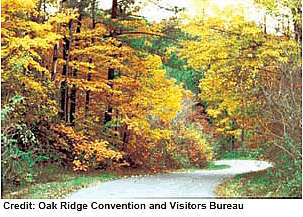Current and Future Chemical Exposures Evaluation

Photo of Oak Trees in the Fall - Credit: Oak Ridge Convention and Visitors Bureau
Public Health Assessment
In 1942, the federal government established the Oak Ridge Reservation (ORR) in Anderson and Roane Counties in Tennessee as part of the Manhattan Project to research, develop, and produce special radioactive materials for nuclear weapons. Four facilities were built at that time. The Y-12 plant, the K-25 site, and the S-50 site were created to enrich uranium. The X-10 site was developed to manufacture and separate plutonium.
As a result of past operations and former waste disposal practices at the ORR, chemical contaminants were released into the environment. In the 1990s, the Tennessee Department of Health (TDOH) conducted a two-phase screening evaluation to analyze past releases (1944 to 1990) and off-site exposures to hazardous substances released from the entire ORR. In 2001, the Agency for Toxic Substances and Disease Registry (ATSDR) reviewed the TDOH’s studies to identify contaminants that required further public health evaluation.
ATSDR conducted a public health assessment (January 2007) to screen recent (1990 to 2003) environmental data collected from the eight-county area surrounding the ORR to determine whether current and future exposures to site-related chemicals (individually or in combination) in off-site soil, sediment, surface water, biota (fish, game, and vegetation), and air posed a public health hazard.
ATSDR determined that exposures to site-related chemicals in soil, sediment, surface water, air, game, and vegetation could occur, but the exposures would not be expected to result in adverse health effects. Because of very limited sampling data, however, ATSDR is unable to determine whether dioxins in fish near the ORR pose a public health hazard. As a protective measure, ATSDR recommends following the state of Tennessee’s current fishing advisories.
Contact Us:
- Agency for Toxic Substances and Disease Registry
4770 Buford Hwy NE
Atlanta, GA 30341-3717 USA - 800-CDC-INFO
(800-232-4636)
TTY: (888) 232-6348
Email CDC-INFO - New Hours of Operation
8am-8pm ET/Monday-Friday
Closed Holidays


